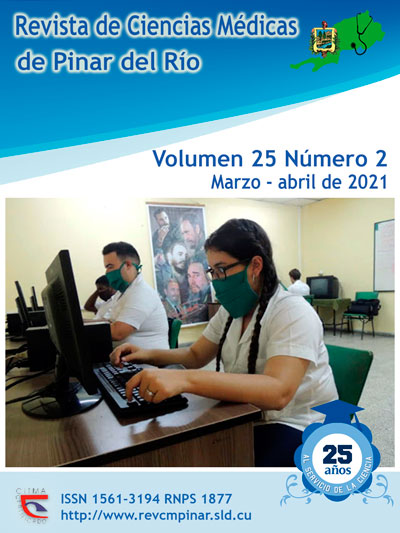Information architecture for the management of computerized medical records for pediatric-ophthalmological specialty
Keywords:
SOFTWARE, TECHNOLOGICAL DEVELOPMENT, MEDICAL RECORDS SYSTEMS, COMPUTERIZED, FORMS AND RECORDS CONTROL, HEALTH RECORDS, PERSONAL, INFORMATION TECHNOLOGY.Abstract
Introduction: the Medical History is a tool that contains the information of patients, which should able to be processed, stored and transmitted in a safe and accessible way, thus it is necessary to use resources and strategies to facilitate healthcare services, among which software designs can be included.
Objective: to develop the information architecture for the management of an computerized medical record to be used in the Pediatric Ophthalmology Office at Pepe Portilla Provincial Pediatric Teaching Hospital in Pinar del Rio.
Methods: a qualitative-quantitative study was conducted, applying theoretical and empirical methods to analyze the evolution and development of a pediatric-ophthalmological history, to characterize the current situation, as well as the introduction of information and communication technologies into this specialty in Cuba.
Results: the design of a prototype of software for the management of a computerized medical record in the Pediatric Ophthalmology Office, with a great social impact for the healthcare institutions where the system is implemented, which benefit both the patient and the professionals.
Conclusion: the implementation of a computerized tool is a strategic decision that can simplify work, optimize time and resources, improving organizational process, management and safety.
Downloads
References
1. Delgado Ramos A, Vidal Ledo M. Informática en la salud pública cubana. Rev Cubana Salud Pública [Internet]. 2006 Sep [citado 01/07/2019]; 32(3). Disponible en: http://scielo.sld.cu/scielo.php?script=sci_arttext&pid=S0864-34662006000300015&lng=es
2. Vialart Vidal MN, Vidal Ledo MJ, Sarduy Domínguez Y, Delgado Ramos A, Rodríguez Díaz A, Fleitas Estévez I, et al. Aplicación de la eSalud en el contexto cubano. RevPanam Salud Pública. 2018 [citado 01/07/2019]; 42: e19. Disponible en: https://doi.org/10.26633/RPSP.2018.19
3. Carnicero J, Fernández A. Sociedad Española de Informática de la Salud. Manual de salud electrónica para directivos de servicios y sistemas de salud. Volumen II: Aplicaciones de las TIC a la atención primaria de salud. CEPAL agosto 2014. [citado 01/07/2019]. Disponible en: https://repositorio.cepal.org/bitstream/handle/11362/37058/S2013311_es.pdf?sequence=1&isAllowed=y
4. Registros médicos electrónicos en América Latina y el Caribe: Análisis sobre la situación actual y recomendaciones para la Región. Washington, DC: OPS, 2016. [citado 01/07/2019]. Disponible en: http://iris.paho.org/xmlui/handle/123456789/28209
5. Martínez García JM. La gestión en Oftalmología: una realidad de nuestros días. Arch Soc Esp Oftalmol [Internet]. 2004 Ene [citado 06/07/2019]; 79(1): 01-02. Disponible en: http://scielo.isciii.es/scielo.php?script=sci_arttext&pid=S0365-66912004000100001&lng=es
6. IBM Más que el AS-400. [Internet]. [citado 06/07/2019]. Disponible en: https://www.xataka.com/especiales/as-400-viejos-rockeros-que-nunca-mueren-sigue-activo-decadas-despues-nacer-hay-demanda-profesionales
7. Oftalmosalus. El Software líder para clínicas oftalmológicas. [Internet]. [citado 2019 Jun 06]. Disponible en: http://www.oftalmosalus.com/
8. Ministerio de Salud Pública. Plan de desarrollo y uso de las Tecnologías de la Información y Comunicaciones del Sistema Nacional de Salud 2017-2021. INFODIR. 2017 [citado 06/07/2019]; 25: 133–57. Disponible en: http://revinfodir.sld.cu/index.php/infodir/article/view/432/512
9. Río Torres M. Historia del Instituto Cubano de Oftalmología "Ramón Pando Ferrer". Rev Cubana Oftalmol [Internet]. 2016 Jun [citado 01/07/2019]; 29(2): 354-381. Disponible en: http://scielo.sld.cu/scielo.php?script=sci_arttext&pid=S0864-21762016000200017&lng=es
10. Fonticoba Valdés LM, Viña Camejo J, Tellería Prieto M del C, Faife Campaña M de los Á, Herrera Serrano B. Gestión de la historia clínica electrónica del servicio de Cirugía Refractiva. Rev Ciencias Médicas [Internet]. 2018 Ago [citado 04/07/2019]; 22(4): 133-141. Disponible en: http://scielo.sld.cu/scielo.php?script=sci_arttext&pid=S1561-31942018000400015&lng=es
Downloads
Published
How to Cite
Issue
Section
License
Authors who have publications with this journal agree to the following terms: Authors will retain their copyrights and grant the journal the right of first publication of their work, which will be publication of their work, which will be simultaneously subject to the Creative Commons Attribution License (CC-BY-NC 4.0) that allows third parties to share the work as long as its author and first publication in this journal are indicated.
Authors may adopt other non-exclusive license agreements for distribution of the published version of the work (e.g.: deposit it in an institutional telematic archive or publish it in a volume). Likewise, and according to the recommendations of the Medical Sciences Editorial (ECIMED), authors must declare in each article their contribution according to the CRediT taxonomy (contributor roles). This taxonomy includes 14 roles, which can be used to represent the tasks typically performed by contributors in scientific academic production. It should be consulted in monograph) whenever initial publication in this journal is indicated. Authors are allowed and encouraged to disseminate their work through the Internet (e.g., in institutional telematic archives or on their web page) before and during the submission process, which may produce interesting exchanges and increase citations of the published work. (See The effect of open access). https://casrai.org/credit/



